IVP New Testament Studies Collection (10 vols.)
Digital Logos Edition
Overview
Additionally, this collection examines the evidence contained in the New Testament and other relevant historical records. The IVP New Testament Studies Collection (10 vols.) offers mature thoughts of some of the finest contemporary evangelical New Testament scholars. These authors, each with their own interpretive approach, help readers assess the contemporary relevance of the ancient texts. They tackle tough questions skeptics often ask and present seasoned and trustworthy insights. The biblical theology that is presented is comprehensive, clear, and readable. The IVP New Testament Studies Collection (10 vols.) provides a great foundation for those seeking to understand the importance and relevance of the gospel and early church in the twenty-first century.
This title is included in the following collections
You can save when you purchase this product as part of a collection.
IVP New Testament Collection (...
$831.75$714.99InterVarsity Press Ultimate Co...
$13,731.48$10,219.99InterVarsity Press Academic Re...
$14,013.38$11,199.99

- Contains insights from various New Testament scholars
- Includes glossaries, indexes, bibliographies, maps, photos, and other helpful resources
- Addresses questions skeptics have asked
- Shows the relevance of the New Testament in our lives today
- Title: IVP New Testament Studies Collection
- Publisher: IVP
- Volumes: 10
- Pages: 4,515
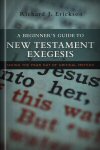
Let’s face it. Just the word exegesis puts some of us on edge. We are excited about learning to interpret the Bible, but the thought of exegetical method evokes a chill. Some textbooks on exegesis do nothing to overcome these apprehensions. The language is dense. The concepts are hard. And the expectations are way too high. However, the skills that we need to learn are ones that a minister of the gospel will use every week.
Exegesis provides the process for listening, for hearing the biblical text as if you were an ordinary intelligent person listening to a letter from Paul or a Gospel of Mark in first-century Corinth or Ephesus or Antioch. This book by Richard Erickson will help you learn this skill. Thoroughly accessible to students, it clearly introduces the essential methods of interpreting the New Testament, giving students a solid grasp of basic skills while encouraging practice and holding out manageable goals and expectations. Numerous helps and illustrations clarify, summarize, and illuminate the principles.
This is a book distinguished not so much by what it covers as by how: it removes the "fear factor" of exegesis. There are many guides to New Testament exegesis, but this one is the most accessible—and fun!
At last! A truly helpful and realistic book on how to do exegesis of the Greek New Testament! Richard Erickson is a skillful and sympathetic guide who has a knack for explaining the process and encouraging beginners to persevere through the necessary steps, methods and approaches required to do responsible exegesis. This is a first-rate book.
—Dr. Larry R. Helyer, Professor of Biblical Studies, Taylor University
This is a very readable and enjoyable beginner’s guide written from the perspective of an experienced teacher for his students. Erickson’s interest shines throughout his engaging book, which will excite readers and help in ‘taking the fear out of critical method’. Highly recommended.
—Journal for the Study of the New Testament, 2007
Richard J. Erickson (PhD, Fuller Theological Seminary) is Associate Professor of New Testament at Fuller Seminary Northwest in Seattle, where he has taught exegesis to students for over twenty years. Erickson has also taught courses at Lutheran Brethren Seminaries in Kaélé, Cameroon, and Sendai, Japan, at Seminario Bíblico de Colombia in Medellín, at Seminario Teológico Presbiteriano San Pablo in Mérida, Yucatán, and at Tyndale Theological Seminary in Amsterdam, The Netherlands. Erickson has published several articles in professional journals and in Faith and Fellowship, the denominational magazine of the Church of the Lutheran Brethren, the church in which he is ordained. He has also presented research papers at professional meetings and is a frequent speaker at various churches and conferences.
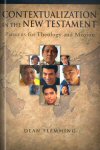
From Cairo to Calcutta, from Cochabamba to Columbus, Christians are engaged in a conversation about how to speak and live the gospel in today’s traditional, modern and emergent cultures. The technical term for their efforts is contextualization. Missionary theorists have pondered and written on it at length. More and more, those who do theology in the West are also trying to discover new ways of communicating and embodying the gospel for an emerging postmodern culture. But few have considered in depth how the early church contextualized the gospel. And yet the New Testament provides numerous examples.
As both a cross-cultural missionary and a New Testament scholar, Dean Flemming is well equipped to examine how the early church contextualized the gospel and to draw out lessons for today. By carefully sifting the New Testament evidence, Flemming uncovers the patterns and parameters of a Paul or Mark or John as they spoke the Word on target, and he brings these to bear on our contemporary missiological task.
Rich in insights and conversant with frontline thinking, this is a book that will revitalize the conversation and refresh our speaking and living the gospel in today’s cultures, whether in traditional, modern, or emergent contexts.
An outstanding and needed book in which Flemming wrestles with New Testament contextualization from the position of deep engagement with New Testament scholarship. He brings to the table the right instinct for missiological issues together with the depth of New Testament study that missiologists are often lacking. This is a must read!
—Scott Moreau, Editor, Evangelical Missions Quarterly
This is the mature work of a careful and caring teacher who has worked in the Philippines as well as in Europe and is well-qualified to handle the questions of how to set the Bible free to speak to different audiences and how we can follow the example of the first missionaries in the settings in which we find ourselves. This is a fine example of biblical scholarship serving the church in its task of holding fast to the apostolic gospel while presenting it in a sensitive, contextualized manner to our contemporaries.
—I. Howard Marshall, Honorary Research Professor of New Testament, University of Aberdeen
Dean Flemming (PhD, University of Aberdeen) is a lecturer in New Testament at European Nazarene College in Buesingen, Germany. An experienced missionary educator, he formerly taught at Asia-Pacific Nazarene Theological Seminary in the Philippines (1987-1997). He has also served on the faculty of the Asia Graduate School of Theology and has taught and spoken in numerous countries throughout Asia, the Pacific, Europe and the Middle East. Flemming has written extensively on the subject of contextualization, as well as a recent commentary on Philippians. An ordained elder in the Church of the Nazarene, he has pastored churches in Ohio and Japan.
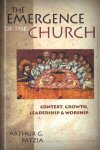
The early church did not descend from heaven on a golden string. Nor did it spring full-grown from the mind of Jesus or the apostles. The church emerged as the result of God’s decisive action within a particular people, Israel, their story, and their historical context. The focal point of this action was Jesus—his ministry, death, and resurrection. But there were challenges, setbacks, and conflicts, as well as bursts of understanding, expansion, and growth. While the main lines of this story display a remarkable unity, a closer examination also reveals a living diversity of cultures, perspectives, and practices.
In The Emergence of the Church Arthur G. Patzia explores the story, weighs the issues, and traces the contours of the early church’s expansion and growth, life and practices, leadership and worship. He offers both a panoramic introduction to the church as it was in the first century and a foundation for considering how it should be in the twenty-first century.
The Emergence of the Church is a carefully crafted and well-executed piece of work, admirably suited to the classroom and useful for private study. It will serve the needs of many students of the first-century church and be a boon to teachers offering courses on the Christian movement in the early decades.
—Ralph P. Martin, former Professor of New Testament, Fuller Theological Seminary
. . . Its fine bibliographies, sensitivity to cultural issues of the Jewish and Greco-Roman contexts and especially its focus on and extensive treatment of both ministry and church order/office and also worship in the first-century church make this a very useful and distinctive textbook.
—David M. Scholer, Professor of New Testament and Associate Dean for the Center for Advanced Theological Studies, School of Theology, Fuller Theological Seminary
Arthur G. Patzia (PhD, McMaster University) is Senior Professor of New Testament at Fuller Theological Seminary of Northern California. He is also the author of Ephesians, Colossians, Philemon in the New International Bible Commentary series.
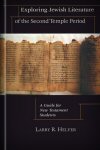
From the crisis of the Babylonian exile to the rise of rabbinic Judaism—a span of over six hundred years—the Jewish people produced a wealth of literature that lies outside the Hebrew Bible. Today it goes under names such as apocrypha and pseudepigrapha, Josephus and Philo, apocalyptic literature, and the Dead Sea Scrolls, Mishnah and targums. But line by line, scroll by scroll, it represents the history and theology, the hopes and prayers of a living and diverse Judaism. It is an engrossing subject in and of itself, but for students of the New Testament it offers an invaluable context for understanding the words and actions of Jesus as well as the conversion and thinking of Paul.
Exploring Jewish Literature of the Second Temple Period is an introduction to this literature and places it within its historical context. Riding the explosive growth of knowledge of this period, Larry R. Helyer guides students to the heart of the matter. What were the pressures and realities, the questions and dreams that nurtured and provoked these written expressions? And how does this literature throw light on the text of the New Testament and origins of Christianity?
The literature of Second Temple Judaism is so vast that few college or seminary students ever receive a decent introduction to it at all. Here, in one volume, are references to judicious samplings from every major corpus, complete with introduction and background, and detailed explanation of relevance for New Testament studies. A wonderful gift for students and professors alike. Perhaps many will now actually teach, and teach substantially, on the topic!
—Craig L. Blomberg, Distinguished Professor of New Testament, Denver Seminary
There are many useful books on Second Temple Jewish literature, for which reason I nearly passed this book by. But once I began actually examining it, I recognized the thoroughness of Larry Helyer’s acquaintance with the sources and how carefully he has prepared this book with New Testament students in mind. I believe it will provide an excellent resource for those who want access to the most important materials for New Testament study.
—Craig S. Keener, Professor of New Testament, Palmer Seminary
Larry R. Helyer was Professor of Biblical Studies for twenty nine years at Taylor University in Upland, Indiana. Now retired, he continues to write on theological topics and serve as an adjunct professor in the United States and abroad. He is the author of Exploring Jewish Literature of the Second Temple Period.
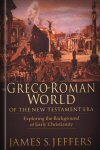
What was life like for first-century Christians? Imagine a modest-sized Roman home of a well-to-do Christian household wedged into a thickly settled quarter of Corinth. In the lingering light of a summer evening, men, women and children, merchants, working poor and slaves, a mix of races and backgrounds have assembled in the dimly lit main room are spilling into the central courtyard. This odd assortment of gathered believers—some thirty in number—are attentive as the newly arrived and travel-weary emissary from Paul reads from the papyrus scroll he has brought from their apostolic mentor.
But if you were to be transported to this scene you would perhaps be overwhelmed by a flood of unexpected difference. The voice of the reader recedes as through open windows the din and clamor of the city assault your ears. Hooves clunk and cart wheels grind and echo from the street while drivers shout, vendors call and neighbors gather and converse. And later, as you accompany a family through darkened and dangerous streets to their third-story tenement apartment, you might try to mask your shock at the cramped and unsafe conditions.
In The Greco-Roman World of the New Testament Era, James Jeffers provides an informative and scenic tour of daily life during the time of Jesus and the apostles. He affords "you-are-there" glimpses of everything from legal codes to dinner foods, from social hierarchy to apartment living, from education to family dynamics. His eye-opening book will advance your understanding of the New Testament and early Christianity and enrich your reading and application of the Bible.
Any student of the New Testament eager to understand its Greco-Roman setting will profit greatly from this excellent book. I commend it highly for its up-to-date perspectives and usefulness. Jeffers writes with a breadth of expertise on the Greco-Roman world that few New Testament specialists can match.
—Craig S. Keener, Professor of New Testament, Palmer Seminary
Where does one go to find a book that provides a clear, simple description of what life was like in the time of Jesus and the apostles? There has been no obvious answer to this question until now. In this outstanding work, James Jeffers has put together a fascinating and engaging treatment of daily life in the world of the New Testament on topics ranging from what people ate for dinner to apartment life in Rome. A careful reading of this book will help many passages in the New Testament come alive.
—Clinton E. Arnold, Associate Professor of New Testament, Talbot School of Theology
James S. Jeffers is associate professor in the Torrey Honors Institute at Biola University, and he teaches ancient history at California State University in Dominguez Hills. He has also written Conflict at Rome: Social Order and Hierarchy in Early Christianity.
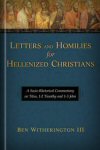
In this socio-rhetorical analytical commentary, Dr. Ben Witherington takes fresh look at the pastoral epistles and Johannine correspondence and provides an analysis of the documents in their socio-religious context discussing their provenance, character, and importance. Dr. Witherington focuses on the unique insights that arise through the social-rhetorical analysis. Throughout, he makes the case for Luke as Paul’s amanuensis for these letters, as well as a strenuous argument against New Testament pseudepigrapha. Features:
- Extended annotated bibliography
- Closer Look sections address the issue of contemporary theological and practical concern
- Bridging the Horizons sections point to the relevancy of the text for today’s readers
. . . this commentary provides solid interpretation of these letters in a very readable style. It is accessible and profitable to the layperson and scholar alike. . . . well worth the investment of time and money.
—Duane F. Watson for The Catholic Biblical Quarterly, 70, 2008
Ben Witherington III (PhD, University of Durham, England) is Professor of New Testament at Asbury Theological Seminary in Wilmore, Kentucky. He is the author of many books on the New Testament, including Women and the Genesis of Christianity, Jesus the Sage, The Jesus Quest and The Paul Quest. A frequent contributor to Beliefnet.com, Witherington has also appeared on numerous TV news programs such as Dateline, 60 Minutes, 20/20 and the Peter Jennings ABC special Jesus and Paul—The Word and the Witness.
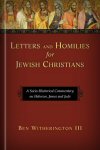
In this commentary on Hebrews, James and Jude, Ben Witherington III applies his socio-rhetorical method to elucidate these letters within their primarily Jewish context, probing the social setting of the readers and the rhetorical strategies of the authors of the letters. Witherington examines the rhetorical and social sciences from a historical viewpoint and seeks to avoid most of the dangers of anachronism by limiting his "rhetorical commentary" to early Jewish rhetoric and Greco-Roman rhetoric which existed during the time. This book also features "Bridging the Horizon" sections to help readers assess the contemporary relevance of these ancient texts, and "Closer Look" sections that explore contemporary issues in more detail.
A perfect volume for those who might want to teach or preach from—but not necessarily specialize in—one of these letters, this commentary serves as an excellent basic reference for these often less familiar and under-appreciated New Testament sermons.
—Amy L. B. Peeler for Koinonia, 2009
The value of this book is that Witherington offers a helpful exegesis of the text and wrestles with the issues that each book raises resulting in a commendable resource for students and pastors.
—Michael F. Bird for Booklist, August 2009
Ben Witherington III (PhD, University of Durham, England) is Professor of New Testament at Asbury Theological Seminary in Wilmore, Kentucky. He is the author of many books on the New Testament, including Women and the Genesis of Christianity, Jesus the Sage, The Jesus Quest and The Paul Quest. A frequent contributor to Beliefnet.com, Witherington has also appeared on numerous TV news programs such as Dateline, 60 Minutes, 20/20 and the Peter Jennings ABC special Jesus and Paul—The Word and the Witness.

Prominent scholar Witherington extends his innovative socio-rhetorical analysis of the New Testament with this in-depth study of 1 & 2 Peter. Dividing the documents according to the socio-religious contexts in which they were written, he sheds new light on the provenance, character, and importance of each. "Bridging the Horizons" sections reveal the text’s relevancy for today’s readers.
This commentary format allows Witherington to showcase his greatest strengths as an exegete—his familiarity with ancient rhetoric, his vast knowledge of both Greco-Roman and Jewish backgrounds, and his keen and creative historical imagination.
—Kelly David Liebengood for Midwestern Journal of Theology, Fall 2008
Witherington writes clearly, interacting with other scholarly viewpoints in a fair manner and providing the reader with a thoughtful and theologically rich commentary.
—The Bible Today, March 2008
Ben Witherington III (PhD, University of Durham, England) is Professor of New Testament at Asbury Theological Seminary in Wilmore, Kentucky. He is the author of many books on the New Testament, including Women and the Genesis of Christianity, Jesus the Sage, The Jesus Quest and The Paul Quest. A frequent contributor to Beliefnet.com, Witherington has also appeared on numerous TV news programs such as Dateline, 60 Minutes, 20/20 and the Peter Jennings ABC special Jesus and Paul—The Word and the Witness.
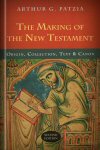
The story of the making of the New Testament is one in which scrolls bumped across cobbled Roman roads and pitched through rolling Mediterranean seas, finally finding their destinations in stuffy, dimly lit Christian house churches in Corinth or Colossae. There they were read aloud and reread, handled and copied, forwarded and collected, studied and treasured. And eventually they were brought together to make up our New Testament.
This revised and expanded edition of The Making of the New Testament is a textbook introduction to the origin, collection, copying, and canonizing of the New Testament documents. Like shrewd detectives reading subtle whispers of evidence, biblical scholars have studied the trail of clues and pieced together the story of these books. Arthur Patzia tells the story, answering our many questions:
- How were books and documents produced in the first century?
- What motivated the early Christians to commit teaching and narrative and vision to papyrus?
- How were the stories and sayings of Jesus circulated, handed down and shaped into Gospels?
- What do we know about ancient letter writing, secretaries and "copy shops"?
- Why were four Gospels included instead of just one?
- How were Paul’s letters, sent here and there, gathered into a single collection?
- Who decided—and by what criteria—which documents would be included in the New Testament?
Explore these questions and more about these Scriptures whose every day, gritty story rings true to their extraordinary message: the palpable mystery of the Word made flesh.
Patzia has produced a clear, lucid and comprehensive beginning introduction to matters concerning the origin and formation of the NT canon, textual criticism, and historical criticism.
—Themelios
Arthur G. Patzia (PhD, McMaster University) is Senior Professor of New Testament at Fuller Theological Seminary of Northern California. He is also the author of Ephesians, Colossians, Philemon in the New International Bible Commentary series.
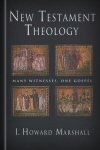
"New Testament theology is essentially missionary theology," writes I. Howard Marshall. Founded on a sure-footed mastery of the data and constructed with clear thinking lucidly expressed, this long-anticipated New Testament theology offers the insights born of a distinguished career of study, reflection, teaching, and writing on the New Testament. Marshall’s New Testament Theology will speak clearly to a broad audience of students and non-specialists. But even on the most familiar ground, where informed readers might lower their expectations of learning something new, Marshall offers deft insights that sharpen understanding of the message of the New Testament.
Here is a New Testament theology that does not succumb to the fashion of settling for an irreconcilable diversity of New Testament voices but argues that "a synthetic New Testament theology is a real possibility. Beginning with the Gospels and Acts, proceeding to each of Paul’s letters, focusing then on the Johannine literature and finally looking at Hebrews and the remaining general epistles, Marshall repeatedly stops to assess the view. And gradually he builds up a composite synthesis of the unified theological voice of the New Testament.
On the way toward this synthesis, Marshall highlights clearly the theological voices of the individual New Testament books. Thus, his New Testament theology serves also as a sort of introduction to the New Testament books, making it double as an attractive complement to book-by-book introductions to the New Testament. Here is a New Testament theology that will not only guide students and delight teachers but also reward expositors with a lavish fund of insights for preaching.
I. H. Marshall surveys the issues and themes of New Testament theology as only the dean of evangelical New Testament scholars could do.
—Douglas J. Moo, Blanchard Professor of New Testament, Wheaton College Graduate School
Few who consult this book, whether for academic or ministry purposes, will fail to benefit.
—Journal of the Evangelical Theological Society, December 2005
I. Howard Marshall (PhD, University of Aberdeen; D.D., Asbury) is Emeritus Professor of New Testament Exegesis and Honorary Research Professor at the University of Aberdeen in Aberdeen, Scotland. Among his numerous publications on the New Testament are his commentaries on the Gospel of Luke, Acts, 1-2 Thessalonians, the Pastoral Epistles, 1 Peter and 1-3 John. He is coauthor of Exploring the New Testament: A Guide to the Letters and Revelation and coeditor of the New International Greek Testament Commentary series, as well as the author of the series’ volume on Luke. He has also authored New Testament Theology: Many Witnesses, One Gospel.
Reviews
12 ratings
joe_bourne1951@hotmail.com
12/24/2017

Roberto Diaz
8/28/2017
I am motivated and excited to have this resource in my LOGOS Library. The insights provided about each book of the volume has really help me to understand how I can use each book, for teaching and preaching, for learning in more depths the cultural,social, and historical context of the NT.
Maryellen J Lewis
12/8/2016
Anthony Sims
5/12/2015

Unix
1/7/2015

John L. Jefferson
9/10/2014

Serge Descoeurs
8/19/2014
Aaron Wong
12/17/2013

Clifford B. Kvidahl
12/1/2013